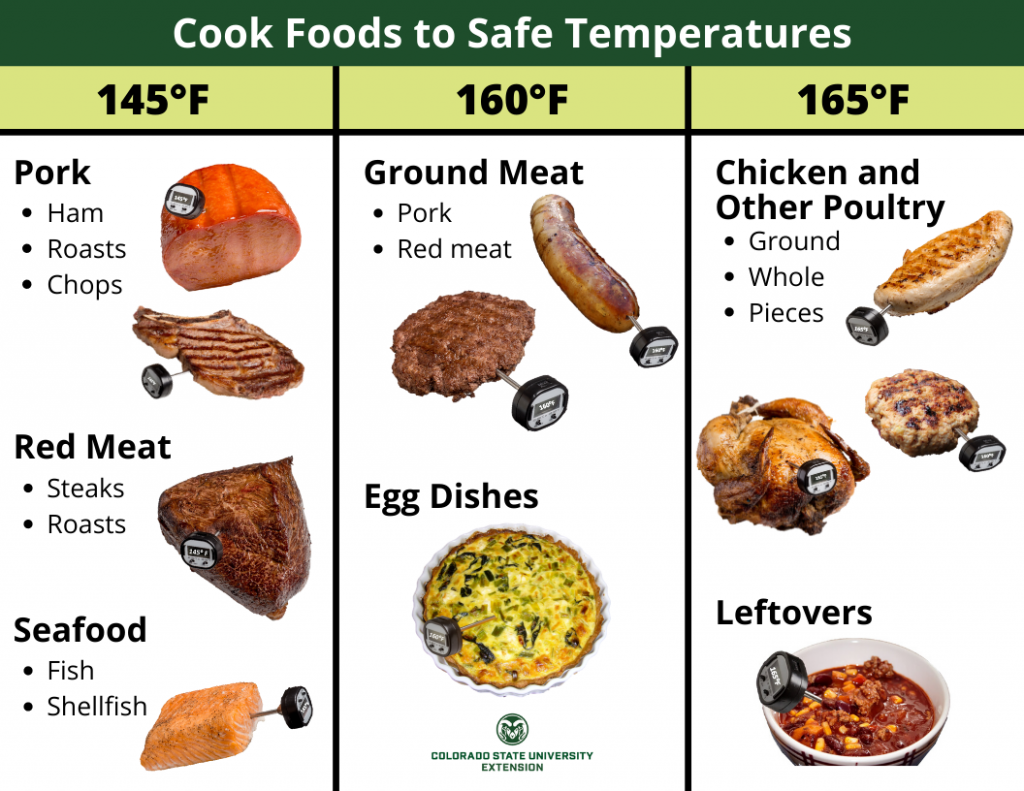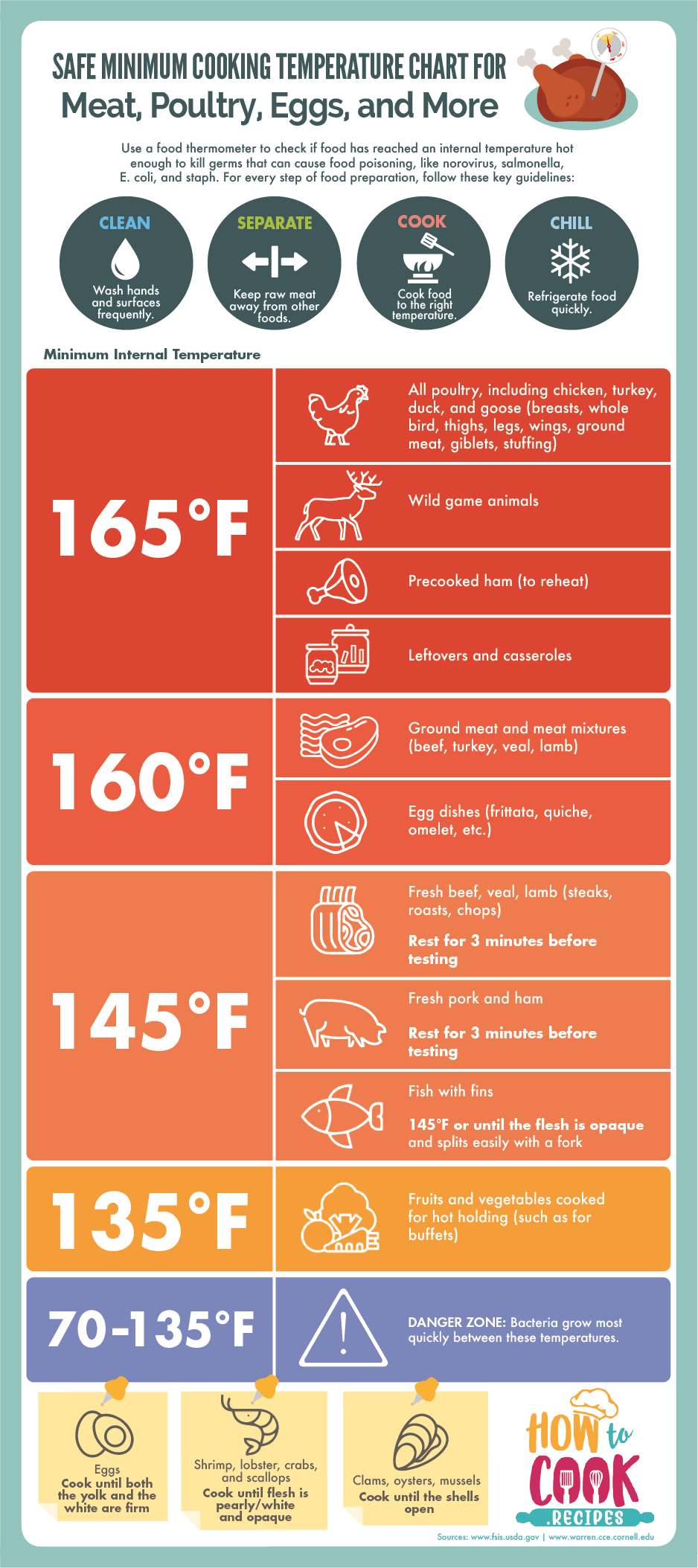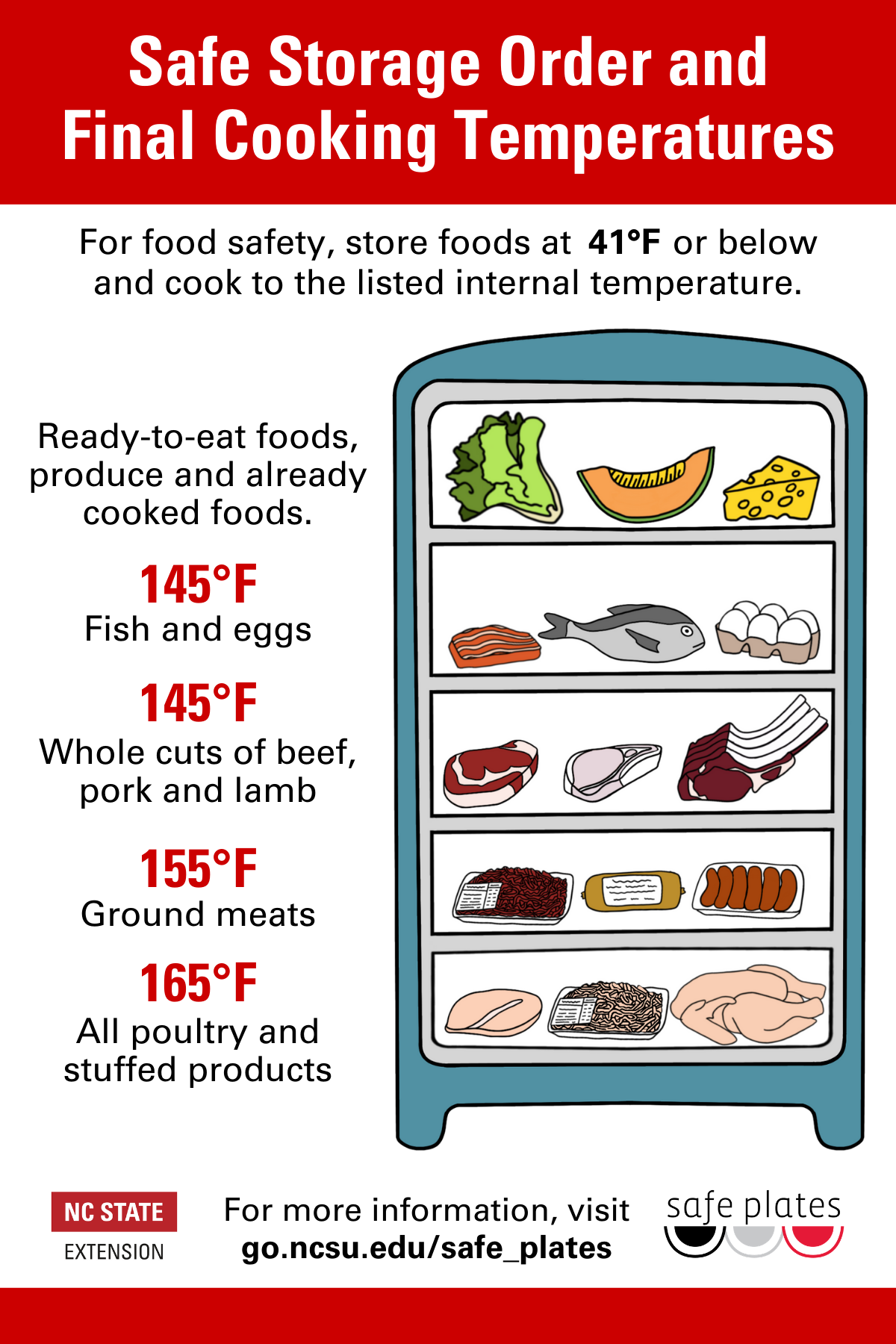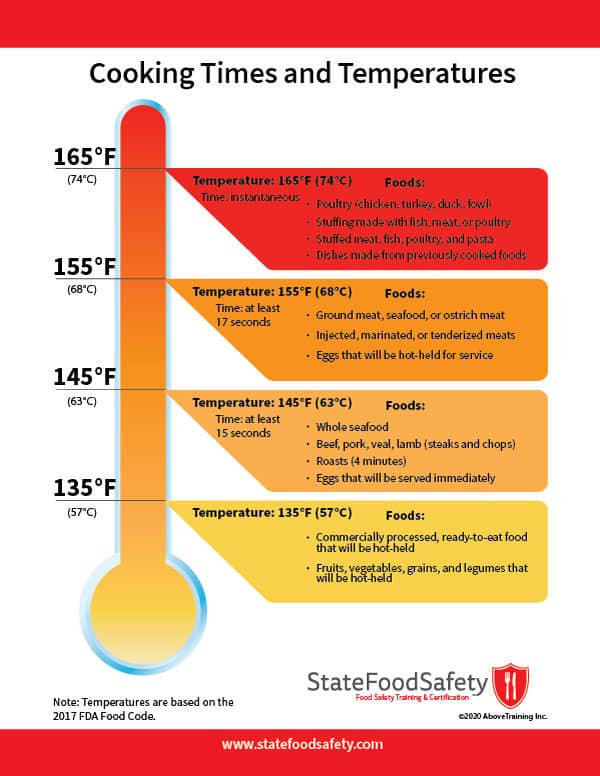Safe cooking temperatures are crucial to prevent foodborne illnesses. The recommended cooking temperature varies depending on the type of food, but it is important to always use a food thermometer to ensure that the temperature is reached and maintained throughout the cooking process.
Food safety is a top priority when it comes to cooking. One of the most important aspects of food safety is ensuring that food is cooked to the correct temperature to kill harmful bacteria. Consuming undercooked or raw meat, poultry, eggs, and seafood can lead to foodborne illnesses such as salmonella, E.
coli, and listeria. It is essential to use a food thermometer to accurately measure the internal temperature of the food. In this blog post, we will discuss the safe cooking temperatures for various types of food and provide tips for cooking safely at home.

The Importance Of Safe Cooking Temperatures
Safe cooking temperatures are essential for preventing foodborne illnesses and retaining food quality and flavor. Cooking foods to the proper temperatures helps kill harmful bacteria and pathogens that can cause illness. For example, poultry should be cooked to an internal temperature of 165°F, while ground meats should reach 160°F. It’s also important to ensure that seafood reaches an internal temperature of 145°F, and leftovers are reheated to 165°F. By using a food thermometer, you can accurately measure the internal temperature of foods and ensure they are safe to eat. In addition to preventing illnesses, cooking to the correct temperatures also helps maintain the quality and flavor of the food, providing a better dining experience for everyone.
Measuring Temperature Correctly
When cooking, it’s crucial to measure temperature correctly to ensure food safety. There are different types of food thermometers available, including digital, instant-read, and oven-safe thermometers. It’s important to choose the right thermometer for the specific dish being prepared.
Proper use and placement of the thermometer is essential. When using a food thermometer, it should be inserted into the thickest part of the food, away from any bones or fat. For example, when cooking poultry, the thermometer should be inserted into the inner thigh and thickest part of the breast.
Temperature Guidelines For Different Foods
When it comes to safe cooking, it is essential to know the appropriate temperatures for different types of foods. This ensures that harmful bacteria are destroyed, reducing the risk of foodborne illnesses.
Red Meat, Poultry, And Seafood
For red meat, such as beef and lamb, the internal temperature should reach a minimum of 145°F (63°C) for medium-rare and 160°F (71°C) for medium. Poultry, including chicken and turkey, should be cooked to an internal temperature of 165°F (74°C) to ensure it is safe to consume. Seafood, such as fish and shellfish, should also be cooked to an internal temperature of 145°F (63°C) to kill any bacteria present.
Eggs, Dairy, And Leftovers
Eggs should be cooked until the whites and yolks are firm. This can be achieved by cooking them to an internal temperature of 160°F (71°C). Dairy products, like milk and cheese, are generally safe to consume without cooking. However, if they are included in a recipe, ensure that the dish reaches an internal temperature of 165°F (74°C). Leftovers should be reheated to a minimum internal temperature of 165°F (74°C) to kill any bacteria that may have grown.
High-risk Foods And Their Safe Temperatures
High-Risk Foods and Their Safe Temperatures:
| High-Risk Ingredients | Safe Temperature |
|---|---|
| Poultry (chicken, turkey) | 165°F (74°C) |
| Ground meats (beef, pork) | 160°F (71°C) |
| Eggs and egg dishes | 160°F (71°C) |
| Seafood and fish | 145°F (63°C) |
| Leftovers and casseroles | 165°F (74°C) |
Identifying high-risk ingredients is crucial for ensuring food safety. Properly cooking these ingredients to their safe temperatures helps eliminate harmful bacteria and reduces the risk of foodborne illnesses. Poultry, such as chicken and turkey, should reach an internal temperature of 165°F (74°C) to kill any bacteria present. Ground meats, like beef and pork, should be cooked to 160°F (71°C). Eggs and egg dishes also require a temperature of 160°F (71°C) to eliminate any potential salmonella contamination.
Seafood and fish should be cooked to an internal temperature of 145°F (63°C) to ensure they are safe to consume. When reheating leftovers or casseroles, it’s important to heat them to 165°F (74°C) to kill any bacteria that may have grown during storage. These safe cooking temperatures are especially important for vulnerable populations, such as young children, pregnant women, and the elderly, who may be more susceptible to foodborne illnesses.
Thawing And Marinating Safely
Proper thawing and marinating techniques are essential for ensuring that your food is safe to eat. When it comes to thawing, it is best to do so in the refrigerator or using the cold water method. Avoid thawing at room temperature, as this can allow bacteria to grow. When marinating, always use a non-reactive container and never reuse marinade that has come into contact with raw meat. Additionally, be sure to marinate in the refrigerator and not at room temperature. By following these thawing and marinating do’s and don’ts, you can help to prevent foodborne illness and keep your meals safe and delicious.
| Thawing Techniques | Marinating Do’s and Don’ts |
|---|---|
| – Refrigerator | – Use a non-reactive container |
| – Cold water | – Never reuse marinade that has come into contact with raw meat |
| – Microwave (only if cooking immediately afterwards) | – Marinate in the refrigerator, not at room temperature |

Cooking Methods And Temperature Control
Ensure safe cooking by using the correct temperatures for various methods. Always refer to recommended temperature guidelines to prevent foodborne illnesses and ensure a delicious, safe meal. Use a food thermometer to accurately measure the internal temperature of the food.
| Cooking Method | Safe Internal Temperature |
|---|---|
| Oven | 165°F (73.9°C) |
| Stovetop | 165°F (73.9°C) |
| Grill | 165°F (73.9°C) |
| Slow Cookers | 165°F (73.9°C) |
| Sous-vide | 130°F-140°F (54.4°C-60°C) for beef, lamb, and pork 145°F (62.8°C) for fish 165°F (73.9°C) for poultry |
Resting Time After Cooking
Resting meat after cooking is crucial for ensuring safety and achieving the desired taste and texture. When meat is cooked, the internal temperature rises, causing the proteins to denature and the juices to redistribute. Allowing the meat to rest after cooking allows these processes to continue, resulting in a more tender and flavorful final product.
Resting times may vary depending on the type and size of the meat. For example, a large roast may require a longer resting time compared to a smaller cut of meat. Here are some general guidelines for resting times:
| Meat Type | Resting Time |
|---|---|
| Beef (roasts and steaks) | 10-20 minutes |
| Pork (roasts and chops) | 5-10 minutes |
| Poultry (whole or large cuts) | 15-20 minutes |
| Fish | 5 minutes |
Remember to always use a meat thermometer to ensure that the internal temperature of the meat reaches the recommended safe cooking temperature before resting. This helps to prevent the growth of harmful bacteria and ensures that the meat is safe to eat.

Storing And Reheating
Safe storage temperatures are crucial to maintain food quality and prevent the growth of harmful bacteria. Refrigerators should be set at or below 40°F (4°C) to keep perishable foods fresh. Freezers, on the other hand, should be set at 0°F (-18°C) to maintain the quality of frozen foods. It is important to store raw meats, poultry, and seafood in separate containers to avoid cross-contamination.
When reheating leftovers, make sure they reach a safe internal temperature to eliminate any bacteria that may have grown. Use a food thermometer to ensure the temperature reaches at least 165°F (74°C). Reheating leftovers in the microwave? Stir the food well and rotate the dish to distribute heat evenly. Always cover the food to prevent drying out and maintain moisture.
Frequently Asked Questions
What Are The Fda Guidelines For Cooking Temperatures?
The FDA recommends cooking poultry to an internal temperature of 165°F and ground meats to 160°F. For whole cuts of beef, pork, veal, and lamb, the safe temperature is 145°F with a 3-minute rest time. Fish should be cooked to an internal temperature of 145°F.
What Is The 40 140 4 Rule?
The 40 140 4 rule is a guideline for writing tweets. It suggests that tweets should be no more than 40 characters for better engagement, have a maximum of 140 characters to leave room for retweets, and include no more than 4 hashtags for optimal visibility.
Following this rule can help improve the effectiveness of your tweets.
What Is The Safe Temperature To Heat Food?
The safe temperature to heat food is 165°F (74°C) to kill harmful bacteria and ensure safety.
What Is The Maximum Safe Food Temperature?
The maximum safe food temperature is 165°F (74°C) according to the USDA. This temperature is required to kill harmful bacteria and prevent foodborne illness. Use a food thermometer to ensure that food reaches this temperature before consuming or serving.
Conclusion
It’s crucial to cook foods to their recommended safe temperatures to prevent foodborne illnesses. By using a food thermometer and following guidelines, you can ensure the safety of your meals. Understanding these temperatures is essential for maintaining good health and well-being.
Stay safe and enjoy your delicious, properly cooked meals!

